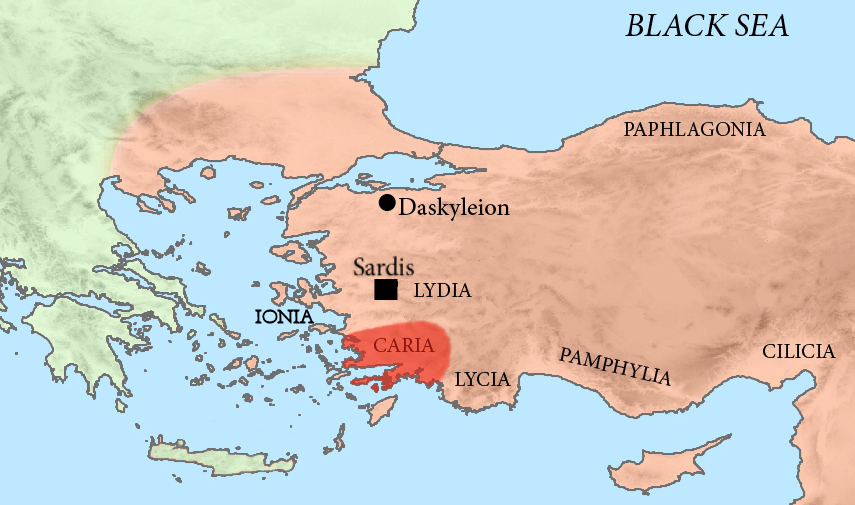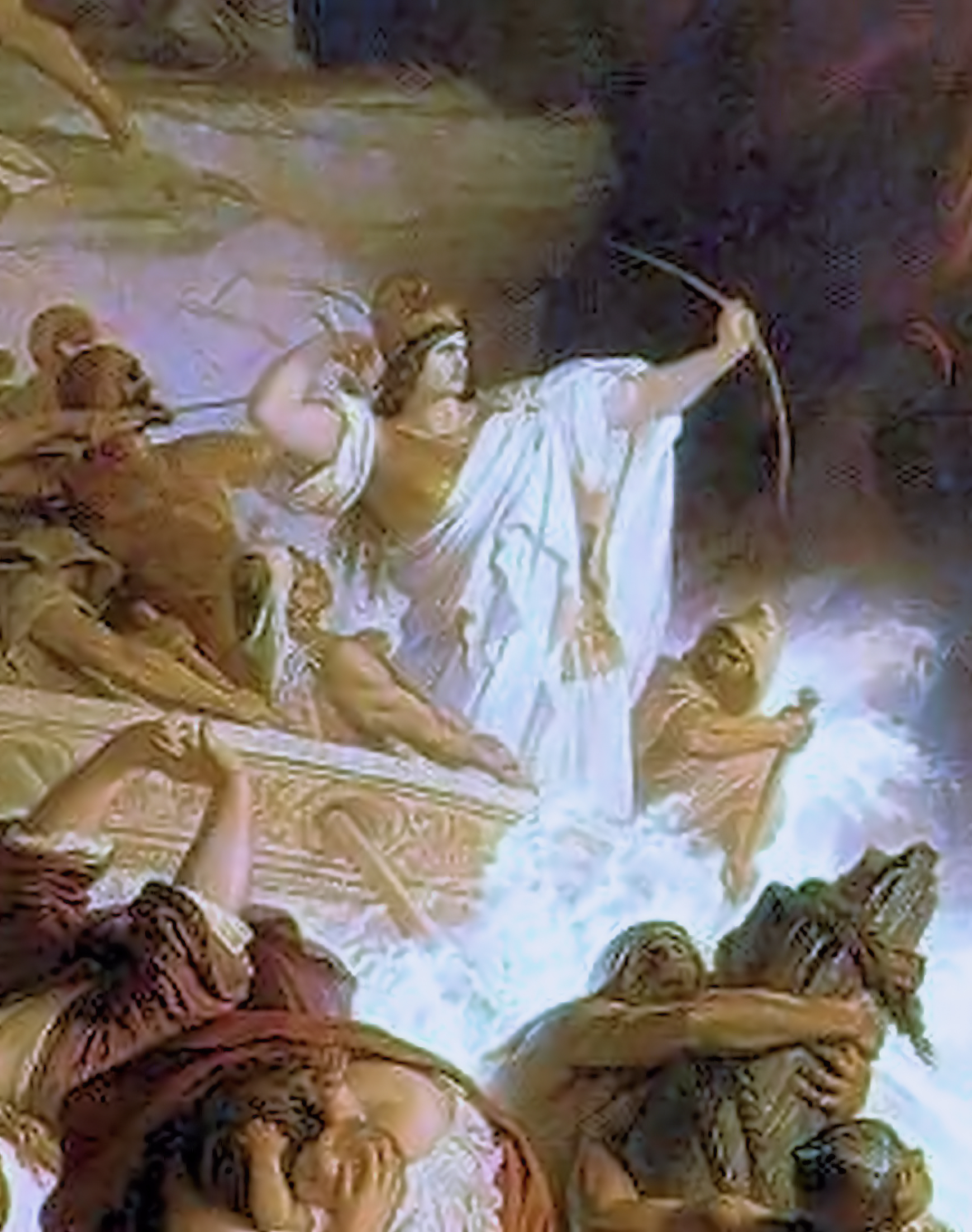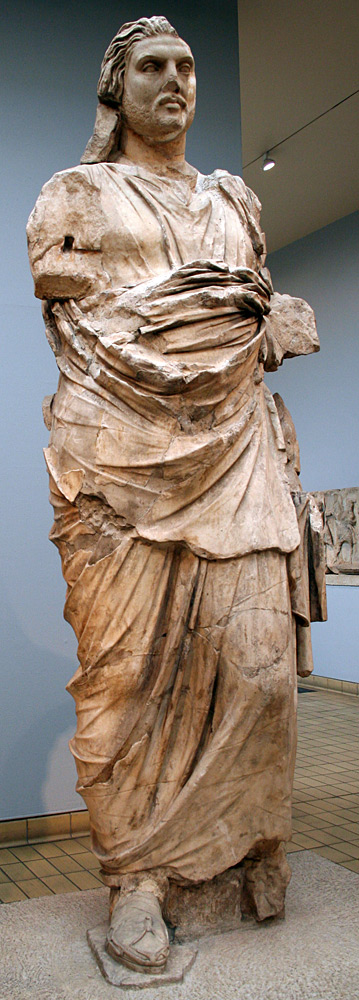|
Lygdamis II Of Halicarnassus
Lygdamis II ( gr, Λύγδαμις) (ruled c.460-454 BCE) was a tyrant of Caria during the 5th century BCE, under the Achaemenid Empire. His capital was in Halicarnassus. He was the grandson of Artemisia, and son of Pisindelis, the previous tyrant. Lygdamis assassinated the poet Panyassis, uncle of famous historian Herodotus, in 461, which forced Herodotus to leave his native city of Halicarnassus, fleeing to the island of Samos. After the death of Lygdamis, circa 454 BCE, Halicarnassus joined the Athenian alliance, known as the Delian League. At that time, Halicarnassus started to appear on the Athenian tribute quota lists. From 395 BCE, Caria would again fall under the control of the Achaemenid Empire and be ruled by a new dynasty of local tyrants, the Hecatomnids The Hecatomnid dynasty or Hecatomnids were the rulers of Caria and surrounding areas BCE. The Hecatomnids were satraps (governors) under the Achaemenid Empire, although they ruled with considerable autonomy, a ... [...More Info...] [...Related Items...] OR: [Wikipedia] [Google] [Baidu] |
Caria
Caria (; from Greek: Καρία, ''Karia''; tr, Karya) was a region of western Anatolia extending along the coast from mid-Ionia (Mycale) south to Lycia and east to Phrygia. The Ionians, Ionian and Dorians, Dorian Greeks colonized the west of it and joined the Carian population in forming Greek-dominated states there. Carians were described by Herodotus as being of Minoan civilization, Minoan descent,''The Histories'', Book I Section 171. while he reports that the Carians themselves maintained that they were Anatolian mainlanders intensely engaged in seafaring and were akin to the Mysians and the Lydians. The Carians spoke Carian language, Carian, a native Anatolian language closely related to Luwian language, Luwian. Also closely associated with the Carians were the Leleges, which could be an earlier name for Carians. Municipalities of Caria Cramer's detailed catalog of Carian towns in classical Greece is based entirely on ancient sources. The multiple names of towns and ... [...More Info...] [...Related Items...] OR: [Wikipedia] [Google] [Baidu] |
Tyrant
A tyrant (), in the modern English usage of the word, is an absolute ruler who is unrestrained by law, or one who has usurped a legitimate ruler's sovereignty. Often portrayed as cruel, tyrants may defend their positions by resorting to repressive means. The original Greek term meant an absolute sovereign who came to power without constitutional right, yet the word had a neutral connotation during the Archaic and early Classical periods. However, Greek philosopher Plato saw ''tyrannos'' as a negative word, and on account of the decisive influence of philosophy on politics, its negative connotations only increased, continuing into the Hellenistic period. The philosophers Plato and Aristotle defined a tyrant as a person who rules without law, using extreme and cruel methods against both his own people and others. The ''Encyclopédie'' defined the term as a usurper of sovereign power who makes "his subjects the victims of his passions and unjust desires, which he substitutes ... [...More Info...] [...Related Items...] OR: [Wikipedia] [Google] [Baidu] |
Achaemenid Empire
The Achaemenid Empire or Achaemenian Empire (; peo, 𐎧𐏁𐏂, , ), also called the First Persian Empire, was an ancient Iranian empire founded by Cyrus the Great in 550 BC. Based in Western Asia, it was contemporarily the largest empire in history, spanning a total of from the Balkans and Egypt in the west to Central Asia and the Indus Valley in the east. Around the 7th century BC, the region of Persis in the southwestern portion of the Iranian plateau was settled by the Persians. From Persis, Cyrus rose and defeated the Median Empire as well as Lydia and the Neo-Babylonian Empire, marking the formal establishment of a new imperial polity under the Achaemenid dynasty. In the modern era, the Achaemenid Empire has been recognized for its imposition of a successful model of centralized, bureaucratic administration; its multicultural policy; building complex infrastructure, such as road systems and an organized postal system; the use of official languages across ... [...More Info...] [...Related Items...] OR: [Wikipedia] [Google] [Baidu] |
Halicarnassus
Halicarnassus (; grc, Ἁλικαρνᾱσσός ''Halikarnāssós'' or ''Alikarnāssós''; tr, Halikarnas; Carian: 𐊠𐊣𐊫𐊰 𐊴𐊠𐊥𐊵𐊫𐊰 ''alos k̂arnos'') was an ancient Greek city in Caria, in Anatolia. It was located in southwest Caria, on an advantageous site on the Gulf of Gökova, which is now in Bodrum, Turkey.} The city was famous for the Mausoleum of Halicarnassus, also known simply as the Tomb of Mausolus, whose name provided the origin of the word "mausoleum". The mausoleum, built from 353 to 350 BC, ranked as one of the seven wonders of the ancient world. Halicarnassus' history was special on two interlinked issues. Halicarnassus retained a monarchical system of government at a time when most other Greek city states had long since rid themselves of their kings. And secondly, while their Ionian neighbours rebelled against Persian rule, Halicarnassus remained loyal to the Persians and formed part of the Persian Empire until Alexander the Gre ... [...More Info...] [...Related Items...] OR: [Wikipedia] [Google] [Baidu] |
Artemisia I Of Caria
Artemisia I of Caria ( grc, Ἀρτεμισία; fl. 480 BC) was a queen of the ancient Greek city-state of Halicarnassus and of the nearby islands of Kos, Nisyros and Kalymnos,Enc. Britannica, "Artemisia I" within the Achaemenid satrapy of Caria, in about 480 BC. She was of Carian-Greek ethnicity by her father Lygdamis I, and half-Cretan by her mother. She fought as an ally of Xerxes I, King of Persia against the independent Greek city states during the second Persian invasion of Greece. She personally commanded her contribution of five ships at the naval battle of Artemisium and in the naval Battle of Salamis in 480 BC. She is mostly known through the writings of Herodotus, himself a native of Halicarnassus, who praises her courage and the respect in which Xerxes held her. Family and name Artemisia's father was the satrap of Halicarnassus, Lygdamis I () and her mother was from the island of Crete. She took the throne after the death of her husband, as she had a son, named ... [...More Info...] [...Related Items...] OR: [Wikipedia] [Google] [Baidu] |
Pisindelis
Pisindelis ( grc, Πισίνδηλις), ruled c.460–450 BCE, was a tyrant of Caria, from its capital Halicarnassus, under the Achaemenid Empire. He was the son of Artemisia I of Caria, and part of the Lygdamid dynasty. He was said to be a young man already at the time his mother Artemisia fought at the head of the Carian fleet at the Battle of Salamis (479 BCE) under King Xerxes I. C.T. Newton «On an inscription from Halicarnassus, relating to Lygdamis» in ''Transactions of the Royal Society of Literature of the United Kingdom'', J. Murray, 1870, p.19/ref> He is mentioned by Herodotus as he described the involvement of his mother at Salamis: He probably had to abandon his throne around 452-449 BCE. His son was Lygdamis II of Halicarnassus, Lygdamis II, last tyrant of the Lygdamid dynasty The Lygdamid dynasty ( BCE) was a dynasty of tyrants in the region of Caria, who were subordinate to the Achaemenid Empire following the conquests of Cyrus the Great through his ge ... [...More Info...] [...Related Items...] OR: [Wikipedia] [Google] [Baidu] |
Panyassis
Panyassis of Halicarnassus, sometimes known as Panyasis ( grc, Πανύασις), was a 5th-century BC Greek epic poet from Halicarnassus in the Persian Empire (modern-day Bodrum, Turkey). Life Panyassis was the son of Polyarchus ( grc, Πολύαρχος) from Halicarnassus, but the historian Duris of Samos claimed that Panyasis was the son of Diocles ( grc, Διοκλῆς) and from Samos. In addition, the historian Herodotus was either his nephew or his cousin. There was also another person of the same name, possibly the grandson of the poet, who wrote a work in two books on dreams. In 454 BC, Panyassis was executed for political activities by the tyrant of Halicarnassus and grandson of Artemisia, Lygdamis ΙΙ (), after an unsuccessful uprising against him. Panyasis was ranked by the Alexandrian School with the great epic poets. The Suda encyclopedia mentions Panyassis. Works Panyassis enjoyed relatively little critical appreciation during his lifetime, but was posth ... [...More Info...] [...Related Items...] OR: [Wikipedia] [Google] [Baidu] |
Herodotus
Herodotus ( ; grc, , }; BC) was an ancient Greek historian and geographer from the Greek city of Halicarnassus, part of the Persian Empire (now Bodrum, Turkey) and a later citizen of Thurii in modern Calabria ( Italy). He is known for having written the '' Histories'' – a detailed account of the Greco-Persian Wars. Herodotus was the first writer to perform systematic investigation of historical events. He is referred to as " The Father of History", a title conferred on him by the ancient Roman orator Cicero. The ''Histories'' primarily cover the lives of prominent kings and famous battles such as Marathon, Thermopylae, Artemisium, Salamis, Plataea, and Mycale. His work deviates from the main topics to provide a cultural, ethnographical, geographical, and historiographical background that forms an essential part of the narrative and provides readers with a wellspring of additional information. Herodotus has been criticized for his inclusion of "legends and f ... [...More Info...] [...Related Items...] OR: [Wikipedia] [Google] [Baidu] |
Samos
Samos (, also ; el, Σάμος ) is a Greek island in the eastern Aegean Sea, south of Chios, north of Patmos and the Dodecanese, and off the coast of western Turkey, from which it is separated by the -wide Mycale Strait. It is also a separate regional unit of the North Aegean region. In ancient times, Samos was an especially rich and powerful city-state, particularly known for its vineyards and wine production. It is home to Pythagoreion and the Heraion of Samos, a UNESCO World Heritage Site that includes the Eupalinian aqueduct, a marvel of ancient engineering. Samos is the birthplace of the Greek philosopher and mathematician Pythagoras, after whom the Pythagorean theorem is named, the philosophers Melissus of Samos and Epicurus, and the astronomer Aristarchus of Samos, the first known individual to propose that the Earth revolves around the sun. Samian wine was well known in antiquity and is still produced on the island. The island was governed by the semi-autonomous ... [...More Info...] [...Related Items...] OR: [Wikipedia] [Google] [Baidu] |
Delian League
The Delian League, founded in 478 BC, was an association of Greek city-states, numbering between 150 and 330, under the leadership of Athens, whose purpose was to continue fighting the Persian Empire after the Greek victory in the Battle of Plataea at the end of the Second Persian invasion of Greece. The League's modern name derives from its official meeting place, the island of Delos, where congresses were held in the temple and where the treasury stood until, in a symbolic gesture, Pericles moved it to Athens in 454 BC. Shortly after its inception, Athens began to use the League's funds for its own purposes, which led to conflicts between Athens and the less powerful members of the League. By 431 BC, the threat the League presented to Spartan hegemony combined with Athens's heavy-handed control of the Delian League prompted the outbreak of the Peloponnesian War; the League was dissolved upon the war's conclusion in 404 BC under the direction of Lysander, the Spartan comma ... [...More Info...] [...Related Items...] OR: [Wikipedia] [Google] [Baidu] |
Hecatomnids
The Hecatomnid dynasty or Hecatomnids were the rulers of Caria and surrounding areas BCE. The Hecatomnids were satraps (governors) under the Achaemenid Empire, although they ruled with considerable autonomy, and established a hereditary dynasty. The first satrap of the dynasty was Hecatomnus. He was appointed as the first Carian satrap of Caria in the late 390s BCE. Previously, Caria had been governed as part of Lydia, by the satrap Tissaphernes based in Sardis. Tissaphernes was executed by Tithraustes on the orders of Artaxerxes II Memnon in 395 BCE. If Hecatomnus did not become satrap immediately upon the death of Tissaphernes, he was in office by 392 BCE, when he made war on Evagoras of Salamis on the orders of Artaxerxes II Memnon. Hecatomnus therefore became satrap of Caria BCE. He was previously one of many minor dynasts in Caria. The Hecatomnid dynasty's seat was originally Mylasa, in central Caria. Hecatomnus' father, Hyssaldomus, was also an independent dynast based ... [...More Info...] [...Related Items...] OR: [Wikipedia] [Google] [Baidu] |
Ancient Halicarnassians
Ancient history is a time period from the beginning of writing and recorded human history to as far as late antiquity. The span of recorded history is roughly 5,000 years, beginning with the Sumerian cuneiform script. Ancient history covers all continents inhabited by humans in the period 3000 BCAD 500. The three-age system periodizes ancient history into the Stone Age, the Bronze Age, and the Iron Age, with recorded history generally considered to begin with the Bronze Age. The start and end of the three ages varies between world regions. In many regions the Bronze Age is generally considered to begin a few centuries prior to 3000 BC, while the end of the Iron Age varies from the early first millennium BC in some regions to the late first millennium AD in others. During the time period of ancient history, the world population was already exponentially increasing due to the Neolithic Revolution, which was in full progress. While in 10,000 BC, the world population stood at ... [...More Info...] [...Related Items...] OR: [Wikipedia] [Google] [Baidu] |









